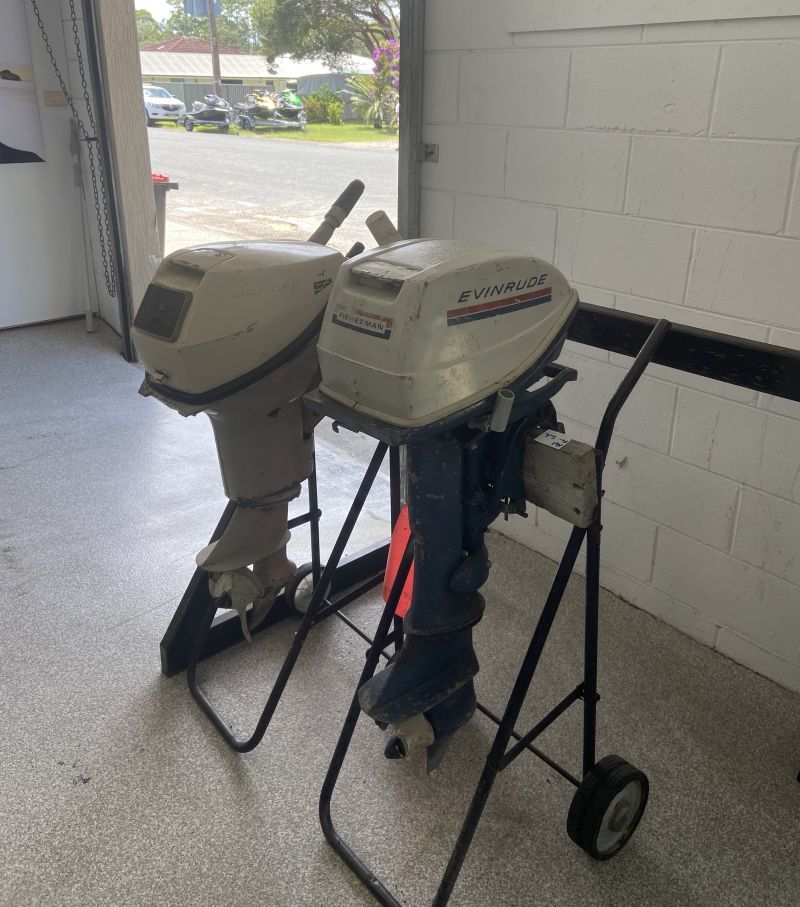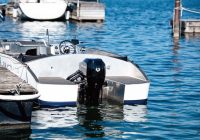Here are two of the most iconic, feted, revered fishing outboards ever built. Both brands – Evinrude and Johnson – were designed by the same engineers, built by the same huge conglomerate, using the same componentry, but they took “badge engineering”, adversity, competition and customer brand loyalty to unheralded levels.

The motor on the right was more or less a staple (with myriad updates and improvements, of course) of OMC’s product line right up until they closed the doors in 2000. It is the ubiquitous, venerable and redoubtable Evinrude Fisherman 6 hp – with, in this particular instance, decals from the 1969 model year. It was a simple, durable, dependable crossflow 2-stroke (all outboards were 2-stroke in those days) of “oversquare” design (i.e. bore bigger than the stroke) of 145cc, with a highly distinctive and evocatively “busy” buzz at a wide throttle opening – even though maximum engine speed was only 4,500 RPM. It’s a safe bet that any kid who ever grew up around boats would have confidently known his or her way around the intricacies and idiosyncrasies of this motor (or its 5 hp predecessor). Pure, unbridled, sentimental nostalgia.
The motor on the left, a 1967 Johnson 9.5hp (this one is Aussie-assembled and cream in colour, rather than the green and white of the US and Belgian versions), is a particular favourite of mine, as we had three of them (and probably bought and sold as many more) when I was growing up in Ireland. The Aussies, with typical irreverence, refer to it as the “toilet bowl model” due to its profile from the rear, which makes it look not unlike a lavatory. Whilst OMC did indeed make the world’s best fishing motors, this wasn’t really one of them – that accolade belongs to the 9.9/15hp series which succeeded the “toilet bowl”, but by the time the 9.5 reached its last year of production (the 1973 model year), its myriad issues had been mostly resolved.
The key issue was that in order to achieve a low profile and centre of gravity, the motor had to be “buried” deep down inside the outer casings (a completely different departure for OMC, which had always traditionally built high-set “power-unit-on-stalk” engines), which meant a squat “pancake”, close-fitting engine cover. The motor also used – again a rare departure for OMC – a rear-mounted down-draught carburettor.
The carburettor intake was so close to the engine cover (foam-lined in those days and prone to absorb moisture) that the engine would often be unable to breathe properly and eventually choke itself to death – this is why it was not unusual to see 9.5s with a series of improvised intake holes under the rear grip. There was also the matter of a) the huge “doughnut” gaiter between the power unit and the exhaust and b) the “concertina” exhaust tube that also deteriorated and caused “gassing”. But these quaint foibles aside, this motor still gives me a warm, fuzzy glow when I think of idyllic days afloat as a kid.
Danny Casey is highly experienced, undoubtedly idiosyncratic, and immensely knowledgeable about things mechanical, new or old. His knowledge and passion are as a result of spending his whole life in or around anything power-driven – especially marine engines. His passion for boating is second to none, with his life a montage of fabulous memories from decades spent in or around water and boats, both here and in Europe. Danny has spent myriad years in the recreational marine industry in a varied career in which he has bamboozled colleagues and competitors alike with his well-honed insight.

His mellifluous Irish accent, however, has at times been known to become somewhat less intelligible in occasional attempts at deliberate vagueness or when trying to prevent others from proffering a counter-argument or even getting a word in. Frank and to-the-point, but with a heart of gold, it can be hard to convince Danny to put pen to paper to share his knowledge. Marine Business News is grateful that he took the time to share his thoughts and insight. Connect with Danny through LinkedIn.
To keep up to date with all marine industry news visit www.marinebusinessnews.com.au









